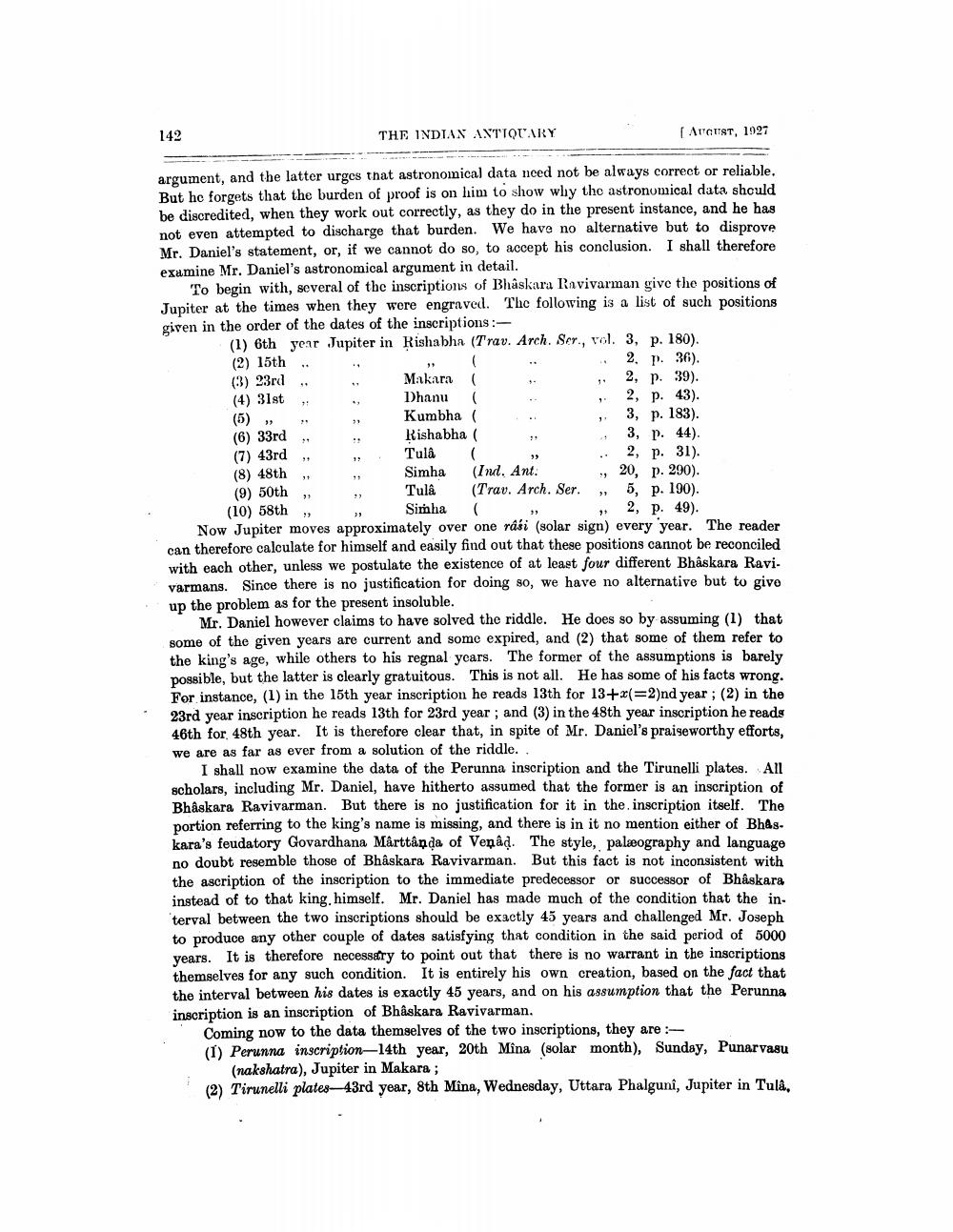________________
142
THE INDIAX ANTIQUARY
[ Araust, 1927
carsi
c
44)
on
argument, and the latter urges that astronomical data need not be always correct or reliable. But he forgets that the burden of proof is on him to show why the astronomical data should be discredited, when they work out correctly, as they do in the present instance, and he has not even attempted to discharge that burden. We have no alternative but to disprove Mr. Daniel's statement, or, if we cannot do so, to accept his conclusion. I shall therefore examine Mr. Daniel's astronomical argument in detail.
To begin with, several of the inscriptions of Bhaskara Ravivarman give the positions of Jupiter at the times when they were engraved. The following is a list of such positions given in the order of the dates of the inscriptions:
(1) 6th year Jupiter in Rishabha (Trav. Arch. Ser., vol. 3, p. 180) (2) 15th ..
2. p. 36). (3) 23rd , Makara (
39). (4) 31st , Dhanu (
2, p. 43). (5) ► Kumbha (
183) (6) 33rd
Rishabha (7) 43rd , Tula (
p. 31). (8) 48th , Simha (Ind. Ant.
20, p. 290). (9) 50th ,
Tula (Trav. Arch. Ser. 5, p. 190). (10) 58th Simha C
► 2, p. 49). Now Jupiter moves approximately over one rási (solar sign) every year. The reader can therefore calculate for himself and easily find out that these positions cannot be reconciled with each other, unless we postulate the existence of at least four different Bhaskara Ravi. varmans. Since there is no justification for doing so, we have no alternative but to give up the problem as for the present insoluble.
Mr. Daniel however claims to have solved the riddle. He does so by assuming (1) that some of the given years are current and some expired, and (2) that some of them refer to the king's age, while others to his regnal years. The former of the assumptions is barely possible, but the latter is clearly gratuitous. This is not all. He has some of his facts wrong. For instance, (1) in the 15th year inscription he reads 13th for 13+x(=2)nd year ; (2) in the 23rd year inscription he reads 13th for 23rd year; and (3) in the 48th year inscription he reads 46th for 48th year. It is therefore clear that, in spite of Mr. Daniel's praiseworthy efforts, we are as far as ever from a solution of the riddle..
I shall now examine the data of the Perunna inscription and the Tirunelli plates. All scholars, including Mr. Daniel, have hitherto assumed that the former is an inscription of Bhâskara Ravivarman. But there is no justification for it in the inscription itself. The portion referring to the king's name is missing, and there is in it no mention either of Bhaskara's feudatory Govardhana Mârttánda of Venâd. The style, palæography and language no doubt resemble those of Bhaskara Ravivarman. But this fact is not inconsistent with the ascription of the inscription to the immediate predecessor or successor of Bhaskara instead of to that king himself. Mr. Daniel has made much of the condition that the interval between the two inscriptions should be exactly 45 years and challenged Mr. Joseph to produce any other couple of dates satisfying that condition in the said period of 5000 years. It is therefore necessary to point out that there is no warrant in the inscriptions themselves for any such condition. It is entirely his own creation, based on the fact that the interval between his dates is exactly 45 years, and on his assumption that the Perunna inscription is an inscription of Bhaskara Ravivarman.
Coming now to the data themselves of the two inscriptions, they are :(1) Perunna inscription-14th year, 20th Mina (solar month), Sunday, Punarvasu
(nakshatra), Jupiter in Makara ; (2) Tirunelli plates-43rd year, 8th Mina, Wednesday, Uttara Phalgunî, Jupiter in Tula,




